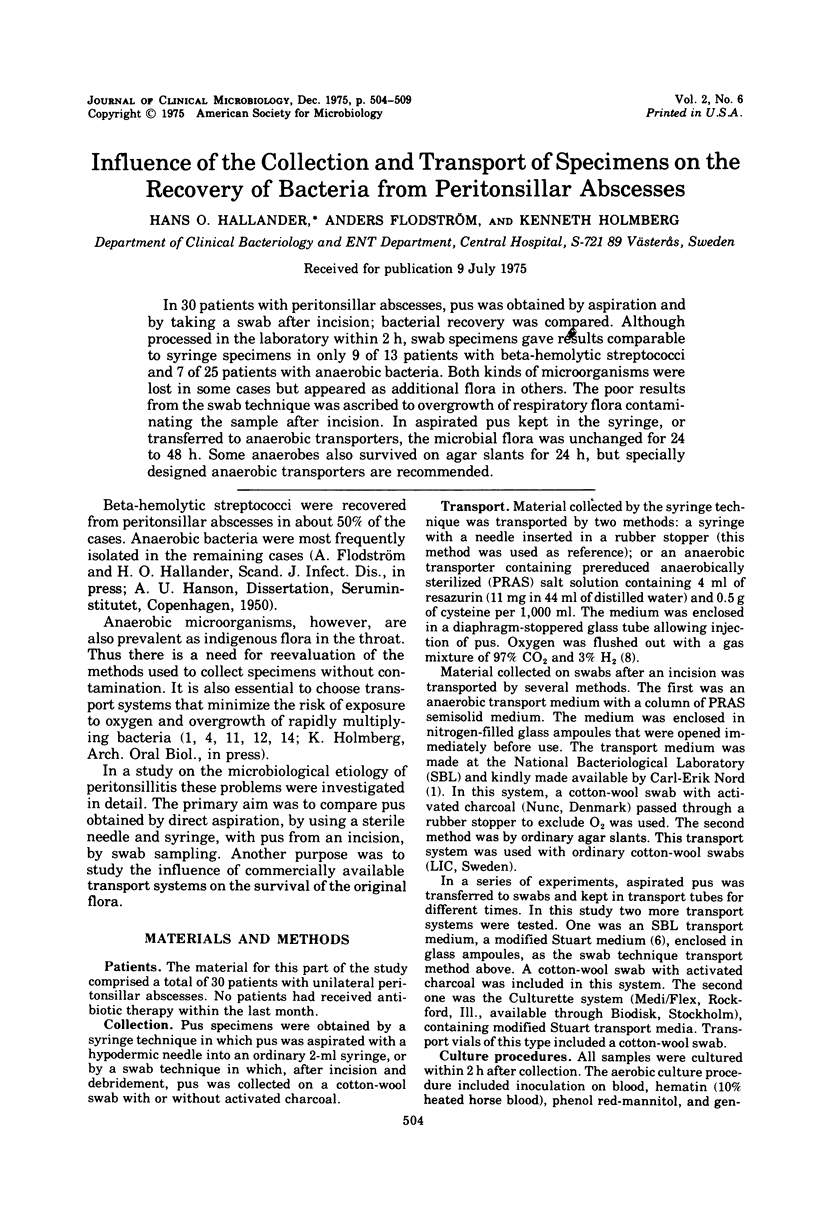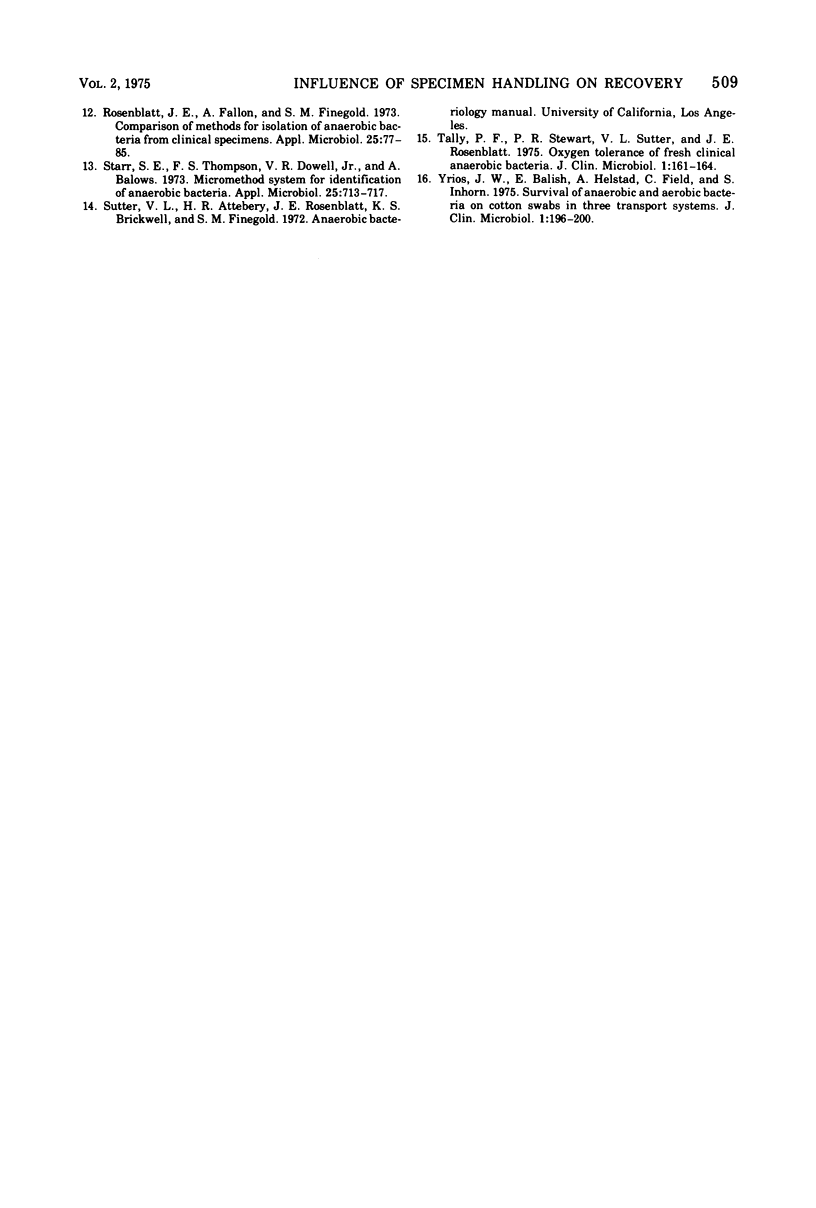Abstract
In 30 patients with peritonsillar abscesses, pus was obtained by aspiration and by taking a swab after incision; bacterial recovery was compared. Although processed in the laboratory within 2 h, swab speciments gave results comparable to syringe specimens in only 9 of 13 patients with beta-hemolytic streptococci and 7 of 25 patients with anaerobic bacteria. Both kinds of microorganisms were lost in some cases but appeared as additional flora in others. The poor results from the swab technique was ascribed to overgrowth of respiratory flora contaminating the sample after incision. In aspirated pus kept in the syringe, or transferred to anaerobic transporters, the microbial flora was unchanged for 24 to 48 h. Some anaerobes also survived on agar slants for 24 h, but specially designed anaerobic transporters are recommended.
Full text
PDF





Selected References
These references are in PubMed. This may not be the complete list of references from this article.
- Bäck E., Nord C. E. Anaeroba infektioner?29H. Lakartidningen. 1975 Mar 19;72(12):1199–1205. [PubMed] [Google Scholar]
- Collee J. G., Watt B., Brown R., Johnstone S. The recovery of anaerobic bacteria from swabs. J Hyg (Lond) 1974 Jun;72(3):339–347. doi: 10.1017/s0022172400023561. [DOI] [PMC free article] [PubMed] [Google Scholar]
- Collee J. G., Watt B., Fowler E. B., Brown R. An evaluation of the Gaspak system in the culture of anaerobic bacteria. J Appl Bacteriol. 1972 Mar;35(1):71–82. doi: 10.1111/j.1365-2672.1972.tb03675.x. [DOI] [PubMed] [Google Scholar]
- Finegold S. M., Rosenblatt J. E. Practical aspects of anaerobic sepsis. Medicine (Baltimore) 1973 Jul;52(4):311–322. doi: 10.1097/00005792-197307000-00010. [DOI] [PubMed] [Google Scholar]
- Gorbach S. L., Bartlett J. G. Anaerobic infections. 1. N Engl J Med. 1974 May 23;290(21):1177–1184. doi: 10.1056/NEJM197405232902106. [DOI] [PubMed] [Google Scholar]
- Gästrin B., Kallings L. O., Marcetic A. The survival time for different bacteria in various transport media. Acta Pathol Microbiol Scand. 1968;74(3):371–380. doi: 10.1111/j.1699-0463.1968.tb03490.x. [DOI] [PubMed] [Google Scholar]
- Killgore G. E., Starr S. E., Del Bene V. E., Whaley D. N., Dowell V. R., Jr Comparison of three anaerobic systems for the isolation of anaerobic bacteria from clinical specimens. Am J Clin Pathol. 1973 Apr;59(4):552–559. doi: 10.1093/ajcp/59.4.552. [DOI] [PubMed] [Google Scholar]
- Loesche W. J. Oxygen sensitivity of various anaerobic bacteria. Appl Microbiol. 1969 Nov;18(5):723–727. doi: 10.1128/am.18.5.723-727.1969. [DOI] [PMC free article] [PubMed] [Google Scholar]
- Martin W. J. Isolation and indentification of anaerobic bacteria in the clinical laboratory. A 2-year experience. Mayo Clin Proc. 1974 May;49(5):300–308. [PubMed] [Google Scholar]
- Rosenblatt J. E., Fallon A., Finegold S. M. Comparison of methods for isolation of anaerobic bacteria from clinical specimens. Appl Microbiol. 1973 Jan;25(1):77–85. doi: 10.1128/am.25.1.77-85.1973. [DOI] [PMC free article] [PubMed] [Google Scholar]
- Starr S. E., Thompson F. S., Dowell V. R., Jr, Balows A. Micromethod system for identification of anaerobic bacteria. Appl Microbiol. 1973 May;25(5):713–717. doi: 10.1128/am.25.5.713-717.1973. [DOI] [PMC free article] [PubMed] [Google Scholar]
- Tally F. P., Stewart P. R., Sutter V. L., Rosenblatt J. E. Oxygen tolerance of fresh clinical anaerobic bacteria. J Clin Microbiol. 1975 Feb;1(2):161–164. doi: 10.1128/jcm.1.2.161-164.1975. [DOI] [PMC free article] [PubMed] [Google Scholar]
- Yrios J. W., Balish E., Helstad A., Field C., Inhorn S. Survival of anaerobic and aerobic bacteria on cotton swabs in three transport systems. J Clin Microbiol. 1975 Feb;1(2):196–200. doi: 10.1128/jcm.1.2.196-200.1975. [DOI] [PMC free article] [PubMed] [Google Scholar]


